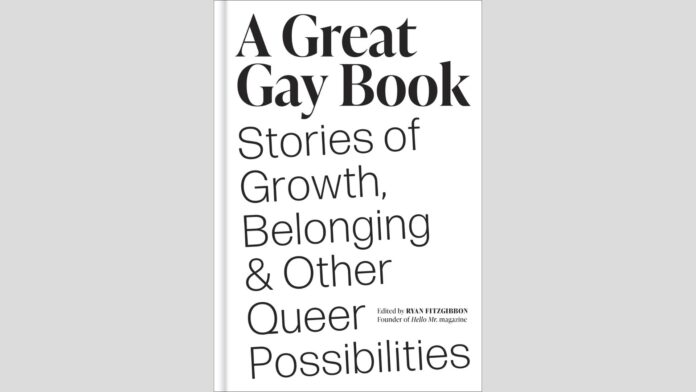The exciting anthology, “A Great Gay Book: Stories of Growth, Belonging & Other Queer Possibilities,” publishing May 21, is edited by Ryan Fitzgibbon, founder of the now defunct “Hello Mr.” magazine. This 432-page volume collects more than 50 interviews, poems, short stories, essays, graphic panels and more. The entries are compelling enough to enjoy back-to-back-to-back, but they are also worth savoring as Fitzgibbon has compiled selections “to encourage reflection.” The arrangement of the pieces often allows readers to consider an idea or topic such as connection, and how we interact with others, to religion’s impact on queer lives, to ideas about gender.
The book certainly lives up to its title. “A Great Gay Book” opens with an article that originally appeared in Fitzgibbon’s “Hello Mr.” magazine entitled, “On Writing a Great, Gay Book.” Hanya Yanagihara, author of “A Little Life,” interviews Garth Greenwell, author of “What Belongs to You” about what it means to be a gay writer and write a gay book. This is bookended by “Saying Hello to New Queer Voices,” in which Colby Anderson, in conversation with Yezmin Villarreal, considers opportunities for queer women and nonbinary and trans writers and content creators.
The design playfully changes type and color in ways that make many entries inviting to read. Most of the stories are short, and Fitzgibbon wisely juxtaposes text and images, so the flow of the book never feels too dense. He includes naughty photo essays such as “Fire Island” by Robert Andy Coombs, and “Screen Test” by Daniel Shea, as well as poems, such as the deliberately designed “Good Dick Is a Myth” by Mack Rogers, to provide nice breathers between some of the wordier selections.
“A Great Gay Book” feels like a big classy zine at times which is quaintly appealing. (Brontez Purnell’s “Fag School #6 ½,” included herein, literally is a republished zine.) Most of the pieces originally appeared in Fitzgibbon’s publication, and a section devoted to each of the cover models from the ten published issues of “Hello Mr” makes it feel like a greatest hits collection.
But such self-indulgence can be forgiven as some of the republished magazine pieces are beneficial to new readers. They also provide some of the best entries. “Kehinde Wiley in 3D” by Antwaun Sargent, is exceptional in how it unpacks visibility. “When you look at me, do you see me?” Wiley asks unflinchingly. Likewise, “The Recording” by Khalid El Khatib, which recounts the author’s tense coming out to his Muslim Palestinian father, is a very moving selection. Equally impressive is “He Opened Up Somewhere Along the Eastern Shore,” by Jason Hanasik, a gay man who has an unexpectedly poignant encounter with a straight man during a road trip they reluctantly take. And “The Mother, The Son, and The Holy Spirit,” by Dany Salvatierra, is a fantastic piece about a gay man who visits his religious mother and has to navigate her world without completely denying his. It is valuable that these entries are now available to reach a wider audience.
There are several memorable essays and interviews that are original to this volume. Chief among them is “Anal Fisting: A Case Study of the Mental and Rectal Elasticity of the Human Male,” in which Sam Finkelstein recalls his fascinating experience performing the titular sex act on a very willing and encouraging stranger and how the encounter impacted each man. “Blurry Soles,” by Mathew Rodriguez, begins with a discussion of a diabetes exam and leads to a consideration of the author’s unabashed foot fetish. Rodriguez’s candor is terrific. And “Back to Start: The ‘Lady’ Bunny,” is Martin Beck’s illuminating conversation with the drag superstar that showcases the performer’s integrity as well as her disdain for political correctness. The book’s biggest misfire, however, is “Shut Up After You’re Thirty: Charles Rogers in Search of John Waters’s Approval,” in which the co creator of the series “Search Party” meets his filmmaking idol and tests the readers’ patience with his anxiety.
“A Great Gay Book” also includes some superb fiction that was originally published elsewhere and is reprinted here. Former PGN editor’s Jason Villemez’s haunting story, “All These Cats Have AIDS,” recounts an activist looking back on a defining moment in his life. It contains vivid imagery, such as sarcomas that “looked like islands [countries].” Likewise, “The House of the Sleeping Beaus,” by John Better Armelia, is an evocative story about a young man who finds work in a brothel in Columbia and is surrounded by a palpable atmosphere of sex.
Fitzgibbon also includes brief entries featuring key queer voices in contemporary gay literature. Bryan Washington’s (“Lot,” “Memorial”) entry, “How to Talk to Strangers,” provides darkly amusing advice, and Ocean Vuong (“On Earth We’re Briefly Gorgeous”) is represented by “Notebook Fragments,” a poem in notebook form from his collection “Night Sky with Exit Wounds.”
One of the book’s highlights is “Clear Constellations: Mapping the Cultural Pinpoints of Critic Wesley Morris,” a profile of the Philadelphia native who is a Pulitzer Prize-winner, a podcaster, and a writer-at-large for the New York Times. As J Wortham interviews him, Morris discusses hearing Nina Simone for the first time, or why he hates the film “Carol.” The engaging conversation ends too soon because one feels Morris has so much more to say.
And “A Great Gay Book” leaves readers wanting more. Hopefully, Fitzgibbon will produce another volume in the future.
“A Great Gay Book: Stories of Growth, Belonging & Other Queer Possibilities” is available May 21.

